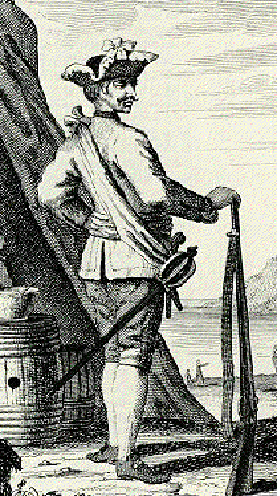(Captain)

Captain Lowther set sail from London down the River Thames in 1721, Past Execution Dock and Newgate Prison, never again to see England again. He had signed on as First Mate to Charles Russell, on board the Gambia Castle, a slaver for the Royal Africa Company. Also on board was Captain Massey, an Army Officer commanding a company of soldiers.
Lowther had never been on a Slave ship and was not aware of what lay ahead of him. The Royal Africa Company was in the business of collecting slaves around the Gambia River. As it was, the slave ships would remain off the coast for months on end until they had a sufficient number of slaves to make their efforts worthwhile. There was little for the crew to do, no place to go on shore, and little to do on the ship. To make matters worse, the weather was unbearable, and diseases such as dysentery, malaria, and scurvy would take its toll on the crew.
Lowther, had from the beginning of the crew, found favor with the crew. Russell, while not a bad Captain, was more concerned with the slave shipment than with the health of the crew. He distrusted Lowther because of how "familiar" he had became with the crew. The division between captain and crew reach a critical point when Russell order Lowther flogged for a minor infraction, and many of the crew took up their marlin spikes and dared anyone to pick up a whip.
What had caused such a division among the crew was the appalling state of condition aboard ship upon reaching Gambia. The slave trade was almost at stand still and the ship remained at dock for a long time. The Royal Africa Company seemed to care little about the crew and to make matters worse, Captain Massey and his soldiers had to retreat from their fort and set up headquarters on board the over crowded ship. It seems that the governor of the Royal Africa Company in Gambia had taken ill from all the mosquitoes and the fort was in such a poor state that it had become unlivable. Massey was furious over the state of affairs his troops were in. He and Lowther met to discuss their situation one night when Captain Russell was not on board and they both decided that they should leave. With that the ship set sail, leaving Russell behind.
At this point Massey was in mind to return to England but Lowther had other thoughts. He immediately summoned the whole crew, plus Massey's soldiers before him and told him his intentions. He explained there was no turning back for himself, for he knew that England would not excuse his actions but if the crew were to vote to return to England his only request was to be set ashore someplace safe. Then he explained his intentions to go "on the account". This was met with a resounding cheer, and all aboard signed the articles of Piracy, electing Lowther as Captain. (It should be mentioned that Massey originally intended to return to England.)
Massey and Lowther formed an uneasy but workable alliance and together the crew of the newly named "Delivery" went on to pillage many a ship, but Massey found it very difficult to adjust to the slow pace of the Sea. He therefore put forth a plan to sack a town. Lowther was completely against such an endeavor due to the many risks it involved. However, as pirate custom demanded, it was put to a vote.
Massey lost by a large margin and with that requested that he and his supporters be allowed to go their own way. Lowther had obtained a second smaller sloop from a previous plunder and was happy to be rid of Massey and his followers. With that Massey and his men parted company of Lowther. This was actually common practice aboard pirate ships with two strong personalities.
Lowther then set sail to the Carolinas, in late 1721, where it is reported he put in to careen his ship, debauch, loot and pillage. More likely he careened, debauched and spent his loot. In any case, shortly after his careenage he left for the Grand Caymans in his newly named Happy Delivery, again on the account. On the way he came upon the Greyhound command by Benjamin Edwards. Lowther ran up "Old Roger" and signaled with a cannon shot for the Greyhound to come to. To his amazement the Greyhound gave him a broadside back. Lowther and his crew prepared Grapplers and Swivel guns and moved in for the fight. The engagement was brief and shortly after the Pirates managed to board, Edwards struck his ensign.
By now, Lowther, had several small ships under him as well as the Happy Delivery and once again went ashore in Guatemala to careen. Unfortunately when his men were in the middle of careening they were attacked by Indians and had to set sail. Several of his crew were lost and some of his ship were left behind or damaged.
Lowther had no choice but to transfer all of his men and their meager supplies to one ship, the Revenge, and continue on. Lowther managed to come across a brigantine well stocked, and with more bluff than anything else, replenish his supplies.
It appeared that Lowther was once again a prosperous pirate by 1722 and his crew was once again happy. Lowther had to once again careen. He chose a small cay called Blanquilla, which is north of Venezuela. It was a small island but well concealed. Lowther order guns, provision and crew on shore which was the customary thing to do and commenced the careenage. They had almost finished when the Sloop, Eagle commanded by Walter Moore spotted the ship.
Lowther and his crew tried to run but it was fruitless so they called for quarter. Moore however was not the forgiving kind. Lowther and about a dozen of his men escaped through a cabin window and headed back to the island. All but four of the pirate were rounded up. It was some time later that Lowther was finally found. As with so many marooned men, he was found with an empty pistol in his hand and a bullet through the brain.

The only author and editor of all pages on the site. Most of what I write about is based on years of book reading on the topic. My first web page was published back in 1994.